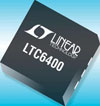ADC driver offers high-speed performance
27 June 2007
Analogue, Mixed Signal, LSI

Linear Technology's new LTC6400-20 ADC driver achieves superb performance on a single 3 V supply. It includes a gain setting resistor, simplifying the challenge of driving the highest performance high-speed ADCs. It provides a fixed gain of 20 dB with -93 dBc third-order intermodulation distortion (IMD3) performance and noise figure of 6,5 dB for a 140 MHz input fre-quency. At 240 MHz, IMD3 is better than -70 dBc. The LTC6400-20 achieves this performance operating on a 3 V supply voltage, providing a differential output voltage swing of 4,4 V peak-to-peak. In addition to minimising power consumption, this eliminates the need for a separate 5 V supply in applications using the latest 3 V and 3,3 V ADCs. To further simplify interfacing to high speed ADCs such as the LTC2208, a VOCM pin sets the output common mode voltage to match the input range of the ADC. An optional on-chip filter helps to handle charge injection common to the capacitive inputs characteristic of pipelined ADCs. Inputs may be AC- or DC-coupled. While fully differential, the LTC6400-20 can be used to easily convert single-ended inputs to differential outputs. It is available in a tiny 3 mm x 3 mm QFN package.
Further reading:
High-speed PIN diode
Altron Arrow
Analogue, Mixed Signal, LSI
Vishay’s new high-speed Silicon PIN diode is able to detect both visible and near infra-red radiation over a wide spectrum range from 350 to 1100 nm.
Read more...
Analogue front end for sensor measurements
Electrocomp
Analogue, Mixed Signal, LSI
The NJU9103 AFE from Nisshinbo is a tiny analogue front end, with a 16-bit resolution ADC and up to 512 x signal amplification from the programmable gain amplifier.
Read more...
Single-channel software configurable I/O
Altron Arrow
Analogue, Mixed Signal, LSI
These use cases of the AD74115H include analogue output and input, digital output and input, resistance temperature detector (RTD), and thermocouple measurement capability.
Read more...
Current-sense amplifier with PWM rejection
Altron Arrow
Analogue, Mixed Signal, LSI
Analog Devices’ AD8410A is a high voltage, high bandwidth current-sense amplifier that features an initial gain of 20 V/V and a 2,2 MHz bandwidth.
Read more...
Combining a LPF and ADC driver for a 20 Vp-p signal
Altron Arrow
Analogue, Mixed Signal, LSI
A mixed-signal ADC driver circuit’s optimum performance depends on multiple variables: the driver’s settling time, the RC filter’s time constant, driving impedance, and the ADC sampling capacitor’s kickback current, all interact during acquisition time and contribute towards sampling errors.
Read more...
Pressure sensor with NextNav certification
EBV Electrolink
Analogue, Mixed Signal, LSI
STMicroelectronics’ LPS22DF pressure sensor has received a NextNav certification, which guarantees performance and reliability for geolocation and other types of applications.
Read more...
Reference design for Raspberry Pi analogue I/O
Analogue, Mixed Signal, LSI
Analogue Devices has published a reference design for ±10 V analogue input and ±15 V analogue output for Raspberry Pi platforms.
Read more...
Multi-zone distance sensor with 90° field of view
Avnet Silica
Analogue, Mixed Signal, LSI
STMicroelectronics has revealed a new FlightSense multi-zone distance sensor, with 90° field of view, to bring lifelike situational awareness to applications like home automation, computers, robots, and smart equipment.
Read more...
Six-axis IMU with Qvar sensing channel
Altron Arrow
Analogue, Mixed Signal, LSI
The LSM6DSV16X from STMicroelectronics is a high-performance, low-power six-axis IMU, featuring a three-axis digital accelerometer and a three-axis digital gyroscope.
Read more...
Bidirectional current-sense amplifier with PWM
RS South Africa
Analogue, Mixed Signal, LSI
The MAX49925 from Analogue Devices is a bidirectional current-sense amplifier (CSA) with an input common-mode range that extends from -40 to 76 V, making it suitable for 48 V HEV applications where there are large automotive transients.
Read more...

